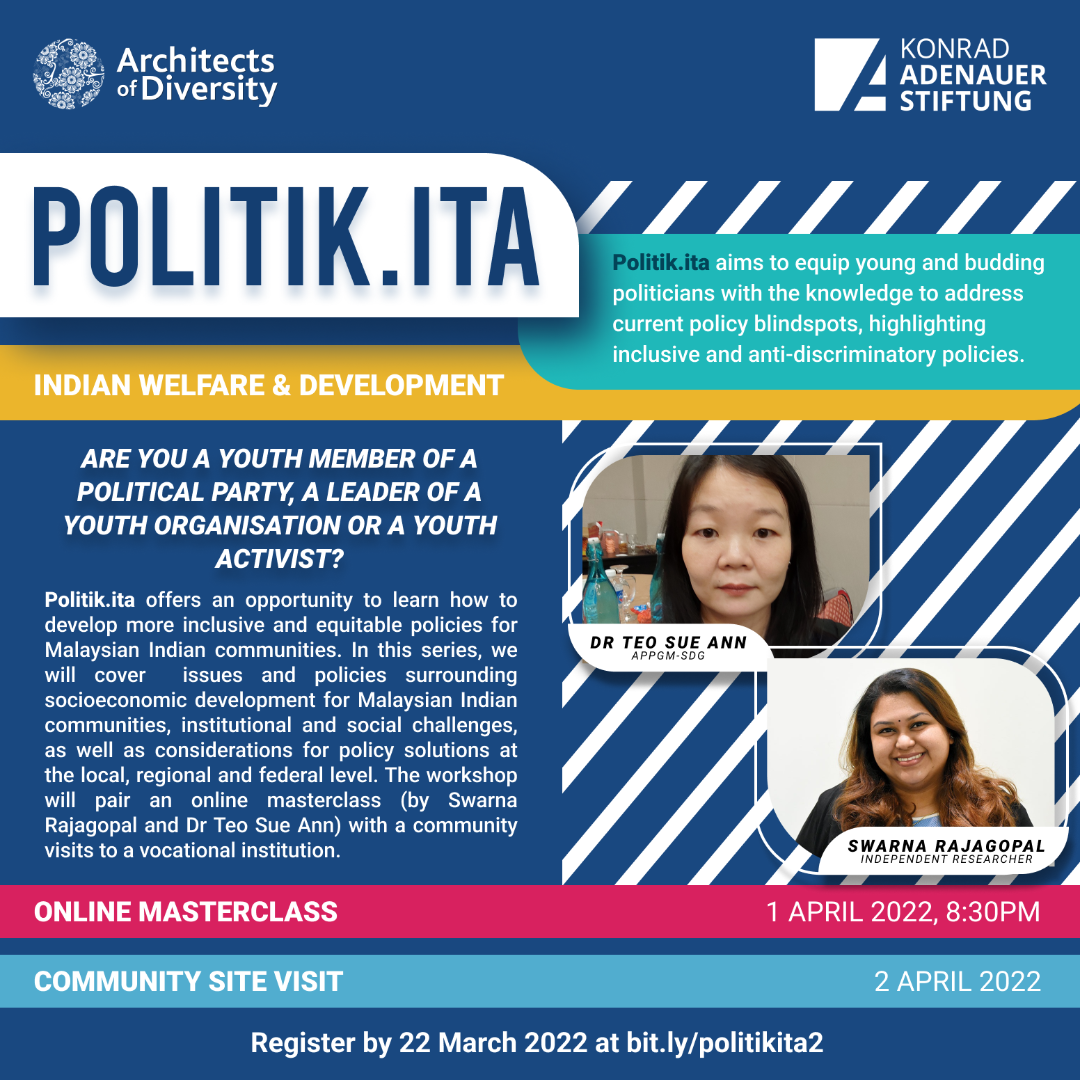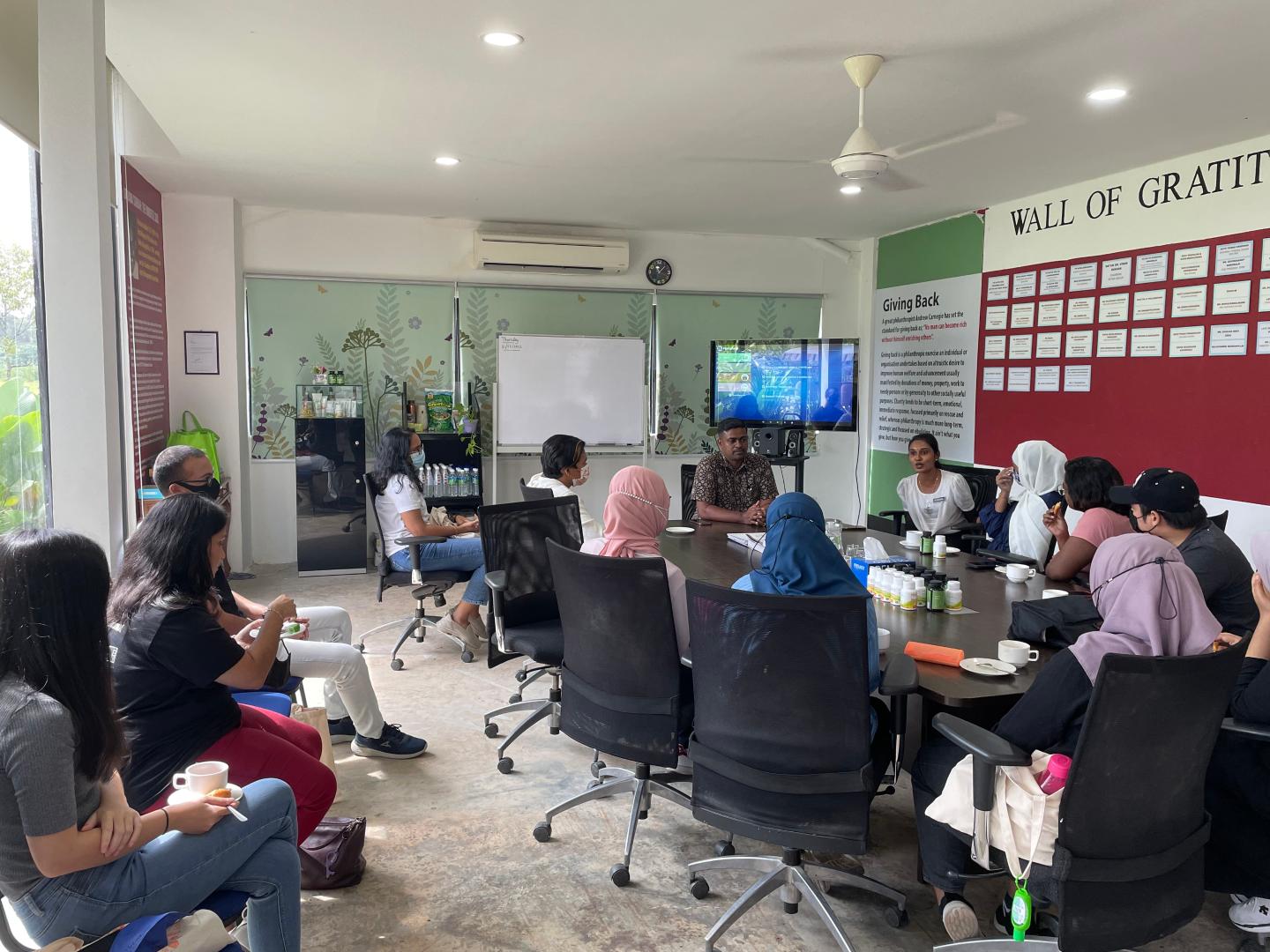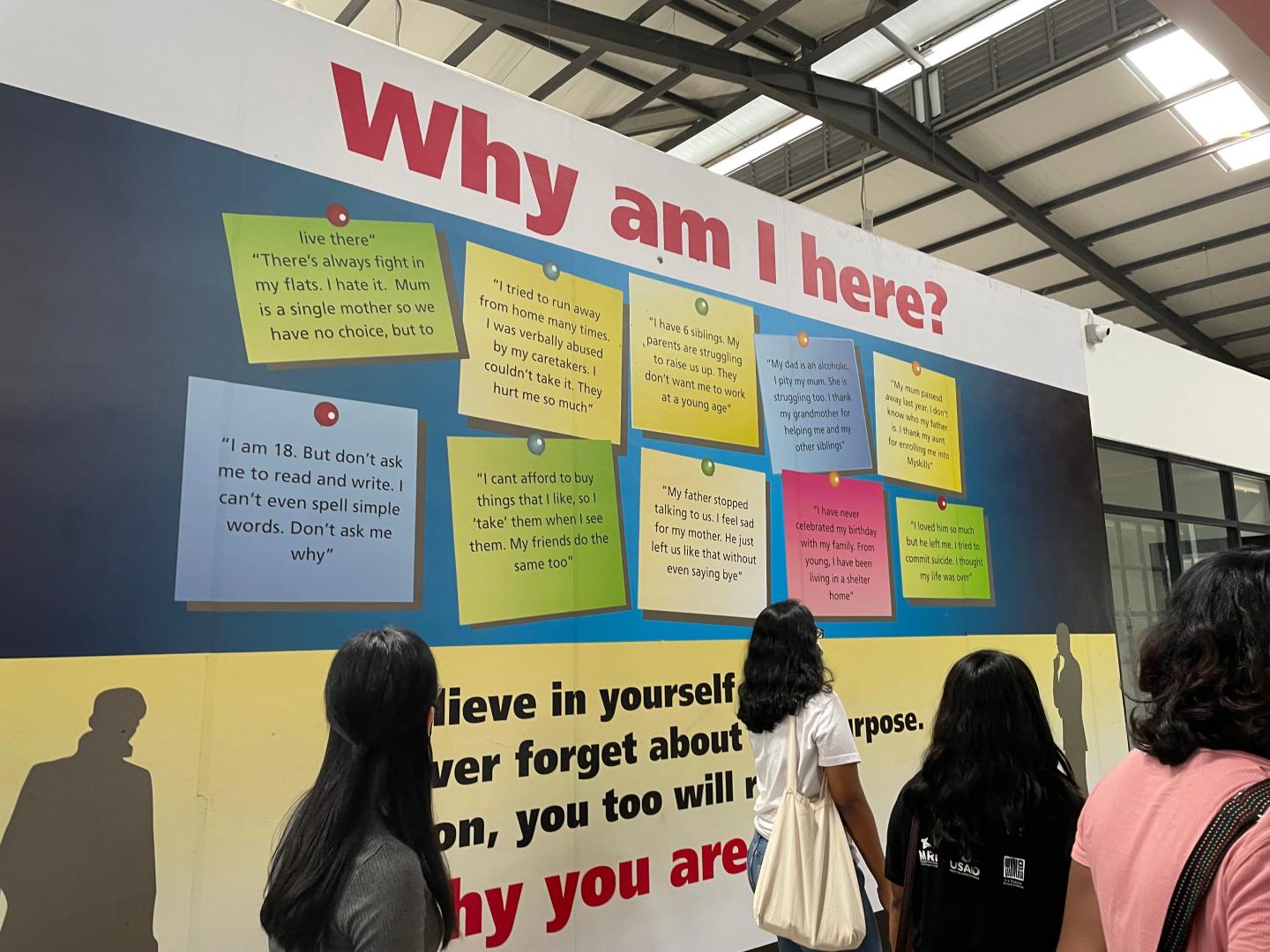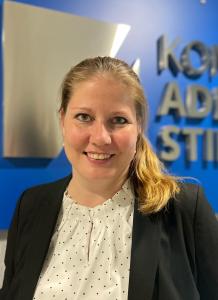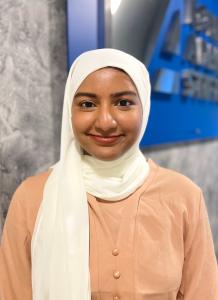Studien- und Informationsprogramm
Details
Supported by Konrad Adenauer Foundation (Konrad-Adenauer-Stiftung), Politik.ita is a capacity-building programme by Architects of Diversity (AOD) Malaysia to equip young politicians and youth with an interest in politics with the knowledge to address current policy blindspots, highlighting inclusive and anti-discrimination policies, through a series of workshops as well as through on-site learning experiences. By the end, these young politicians would be able to better articulate the key steps needed to form robust policy that serves the communities most affected by these issues.
On 1 April 2022, Politik.Ita's second online masterclass, "Indian Welfare & Development" series, Politik.ita covered:
- Background and issues surrounding socioeconomic development of Indian communities
- Institutional and social challenges faced by Indian communities
- Considerations for inclusive policy solutions at the local, regional and federal level
“Do your actions or work prioritise lifting those who have traditionally been excluded from participation? Do you take extra care to ensure that you will listen to those in a lesser position of power?”, AOD’s co-founder, Jason Wee asked 29 participants during his introductory remarks. He explained how there is an urgent need for policymakers to hold themselves accountable when crafting policies that incentivise the concerns of the majority but continuously disempower minority communities from socio-political participation.
Defining Malaysian Indians
Researcher and Liaison Officer of the All-Party Parliamentary Group Malaysia for Sustainable Development Goals (APPGM-SDG), Dr Teo Su Ann commenced the workshop with a question for the floor: Who are Malaysian Indians? Inviting participants to offer their thoughts on the different meanings behind the terms, “Malaysian Indians” and “Malaysian Tamils”. Dr Teo emphasised on the importance of understanding the difference between these two categories. “Tamils can include other Indian [ethnic groups] from [the region of] Tamil Nadu”, she said. “For the Chinese community, they may use clans and it may not be as important for them to distinguish, whereas for Indians, there can be subgroups as one of the terms.”
In addition to Dr Teo’s remarks, researcher, and coordinator of the Georgetown Literary Festival (GTLF) Swarna Rajagopal explained that the identification of Malaysian Indians is best seen from the community’s “lived experiences”. “They may call themselves Tamil but may not be from Tamil Nadu… They may use a bigger umbrella term like “Malaysian Indians” because it is easier to identify themselves”, she said. Some participants also shared their perspectives on Dr Teo’s question, reflecting on their own family history and experiences:
“This was a good question because in all honesty, I’ve been so confused with my identity as a Tamil/Malaysian Indian… My great grandfather and uncle were brought from Sri Lanka to specifically help with the railway work.” – Raenuga Indran
“Tamil origins also cross national boundaries. Not all Tamils come from India. For so long I found it just easier to say I'm Indian eventhough I'm technically not.” – Lhavanya Dharmalingam
“I have stories from my grandparents who came during the British occupation, by themselves – riding bicycles, selling furniture and carpets as well as stories of the Japanese occupation. I got to see the documentation to apply for their national identification cards, including the back-and-forth papers they had to go through.” – Mayna Patel
Caste in Malaysia’s Past and Present
In her presentation, Dr Teo makes an in-depth exploration of the history of Malaysian Indians, from migration to their socio-economic conditions in the colonial plantations of British Malaya. While the shadow of imperialism has painted Indian labourers as “submissive” and “easily manipulated” compared to other racial groups, Dr Teo stated that Malaysian Indians are now often described as “forgotten Malaysians” and even “tragic orphans” for being persistently marginalised in the country’s socio-economic development.
Based on the findings of her PhD thesis on Hinduism and caste politics in the Malaysian landscape, Dr Teo highlighted the widespread academic literature that provide evidence for the preservation of caste hierarchies despite Indian migration to Southeast Asia. Colonial estates were equipped with all sorts of facilities to prevent any of the workers to leave the premises, ensuring different groups would continue to play their respective roles in the political economy. When participants were asked if they believe the concept of caste still exists among Malaysian Indians, a majority agreed while a few disagreed due to their optimism that the community’s mentality is “moving forward”. Dr Teo also affirmed these sentiments by sharing her fieldwork encounters with Malaysian Indian interviewees who denied the relevance of the caste system in the Malaysian context.
“I think class structures affected the stratification of Malaysian Indians in Malaysia in contemporary contexts”, said Abbernaa Dhevi Kukananthan. In response, another participant chimed in to show that the issue of class may feature more dominantly compared to caste for Malaysian Indians today. “I think there is a mix these days - there are Indian Malaysians who have risen, but there are plenty who remain very impoverished and make up a large percentage of the B40 (below 40% of the Malaysian population) community”, Mahija Menon argued.
Current Policy and Recommendations
Since 1974, the Malaysian government and policymakers has developed “blueprints”, a memorandum of understanding (MoU) and special state departments such as the Socio-Economic Development of the Indian Community Unit (SEDIC) and the Malaysian Indian Transformation Unit (MITRA).
Yet, as Swarna cautioned, “Indians being a minority is a half-truth… Some even identify as lain-lain (others)”, showing the challenges with data collection on the socio-economic conditions of Malaysian Indians today. According to the most recent figures of the national labour force published by the Department of Statistics Malaysia (DOSM), the population of non-Malaysian citizens is approximately 40% higher than Malaysian Indians.
“There is missing data on Indians in the labour force especially those who are stateless. The Department of Statistics does not record informal workers despite the Covid-19 pandemic. How are we going to understand [Malaysian Indian] realities and socio-economic conditions if policies at national level are limited by its “top-to-bottom” approach. The DOSM identifies Indians through very macro and narrow perspectives. It is too simplistic, homogenous and limited despite all these years, and it affects how the Blueprints are designed,” Dr Teo ruminated.
“I think a question that comes up a lot, is how to make a policy recommendation practiced? Because I have heard many stories about policy lobbying (especially race-based) being determined by the political climate - what does the ruling party want to do?”, Abbernaa stated.
“A hopeful sign to improve the lives of vulnerable children.” - Haniss Farhaina Haidi, KAS Scholar 2021
"On 1 April 2022, I attended an online workshop hosted by Dr Teo Sue Ann and Swarna Rajagopal which gave me a great insight beyond mainstream academia into the evolvement of the Indian communities in Malaysia, where persisting marginalization can be traced back due to the historical development of the country and up until today.
The following day, 2nd April 2022, I took part in the community site visit to MySkills Foundation campus in Kalumpang, Selangor. It is a rehabilitative and transformational center for the youth-at-risk where students have upmost opportunities to develop social, interpersonal and vocational skills to prepare themselves in an external environment outside the commune. During the campus tour I had the opportunity to have conversations with some of the children in which I immediately befriended a promising student that moved me by her story which consist of resilience and determination for change.
In addition to the experience that I have gained, I also had the biggest honor to personally ask MySkills Foundation’s Chief Executive Officer, Mr. Devasharma Gangadaran on how the MySkills certificate offers a better employment opportunity for the graduates transitioning into the workforce and getting decent jobs as compared to Sijil Pelajaran Malaysia (SPM) leavers. I am astounded by his remarks and I agreed wholeheartedly on what he shared with me. With employers seeking for the technical skills needed to perform certain task and duties for specific occupations, and this is where MySkills Foundation’s certification comes to play.
This genuine pursuit taken by the personages behind MySkills Foundation is a hopeful sign to improve the lives of the vulnerable children – instead of lessening their hope by only focusing on the greater disadvantage of succeeding in life, I believe it is our responsibility to assist them to achieve their longing desire to change for the better."
“Tidak semua orang membesar dengan wang kertas.” - Muhammad Zailan Mohd Zeen, KAS Scholar 2021
"Pada 1 April 2022, saya telah menyertai sebuah webinar yang dihoskan oleh Dr Teo Sue Ann dan juga Swarna Rajagopal. Kedua-dua hos ini mengopak secara lebih mendalam mengenai peranan dan juga penglibatan masyarakat India dalam pembangunan di Malaysia. Dr Teo Sue Ann dan juga Swarna Rajagopal juga menyelitkan juga sejarah kedatangan masyarakat India di Tanah Melayu.
Pada keesokan harinya iaitu pada 2 April 2022, saya telah menglibatkan diri saya bersama-sama dengan rakan-rakan yang lain untuk melawat ke sebuah sekolah yang digelar ‘My Skills Foundation campus’ yang terletak di Kalumpung, Selangor.
Ketika aktiviti lawatan ke sekeliling kampus berlangsung, kami ditemani oleh pelajar-pelajar yang dipilih untuk mengiringi kami. Pada ketika itu, saya mengambil peluang untuk berbual dengan salah seorang pelajar tersebut untuk mengetahui lebih mendalam mengenai liku-liku kehidupan yang mereka lalui sehingga menyebabkan mereka berada di sini. Di sini, saya belajar bahawa, tidak semua orang membesar dengan wang kertas. Ada yang terpaksa bermandikan peluh demi kelangsungan hidup. Bagi saya, mereka lebih tabah daripada saya kerana kehilangan ibu bapa ketika masih kecil berbanding saya yang kehilangan ibu bapa ketika 17 tahun.
Saya mengucapkan ribuan terima kasih kepada Tuan Devasharma Gangadaran iaitu Pengarah kepada ‘MySKills Foundation’ memberikan taklimat dan membuka mata saya tentang kelebihan sekolah ini. Pada masa yang sama menceritakan kesusahan yang dihadapi oleh masyarakat India dalam aspek pendidikan di Malaysia. Saya tertarik dengan petikan yang diutarakan oleh Tuan Devasharma ‘daripada kita menubuhkan pusat-pusat juvana atau menempatkan mereka ke dalam penjara, lebih baik kita membuka sekolah-sekolah pemulihan akhlak dan juga melahirkan lebih ramai masyarakat yang mahir dalam pelbagai bidang kemahiran seperti sekolah-sekolah vokasional’. Saya juga berpendapat yang sama bahawa, kehidupan seseorang itu tidak berakhir daripada keputusan yang gagal ketika mengambil Sijil Pelajaran Malaysia (SPM) kerana semua manusia diciptakan dengan kelebihan masing-masing. Oleh itu, jika seseorang itu tidak menunjukkan minat dalam pelajaran akan tetapi dalam bidang teknikal seperti mekanikal, ibu bapa seharunya menjadi tulang belakang kepada keputusan yang mereka pilih. Tambahan pula, kebanyakkan syarikat-syarikat juga memilih seseorang yang mempunyai pengalaman dan juga kemahiran yang tinggi.
Akhir kalam, saya berharap bahawa segala keputusan yang dilakukan oleh MySkills Foundation akan menjadikan kanak-kanak yang terpilih ini dapat dijadikan sebagai contoh kepada kanak-kanak yang berkongsi nasib dengan mereka. Bukan hanya kanak-kanak cemerlang dalam SPM. Oleh itu, saya juga berharap bahawa semua masyarakat berganding tenaga untuk membantu kanak-kanak yang tidak bernasib baik ini untuk membaiki kisah silam mereka yang sudah lama terkubur dan mewarnainya kembali. Bagi saya, anak muda merupakan tunjang kepada pembangunan dan transformasi negara kerana kelak, mereka yang akan memimpin negara. Oleh itu, untuk merealisasikan matlamat tersebut, kita haruslah daripada awal mendidik mereka kerana bagaimana acuan, begitulah kuihnya."



